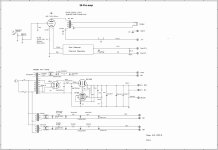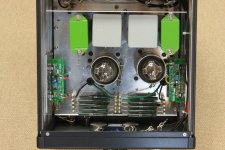If you have trouble finding a 6.3V trafo, choosing a 6V type with more VA than you need will give high voltage.
A 6V 50VA trafo will give about 6.3V when 30% loaded, which is about right for the load of 1A dc-rectified (= ~1,8A rms).
Example split-bobbin trafo 6V 50VA from UK vendor:
Chassis Transformer 2x115V 50VA 6V+6V
In most locations, Hammond transformers are available, and the 266K12 or 266L12 is perfect.
Hammond Mfg. - Power Transformer - Dual Primary / Dual Secondary (266 Series)
A 6V 50VA trafo will give about 6.3V when 30% loaded, which is about right for the load of 1A dc-rectified (= ~1,8A rms).
Example split-bobbin trafo 6V 50VA from UK vendor:
Chassis Transformer 2x115V 50VA 6V+6V
In most locations, Hammond transformers are available, and the 266K12 or 266L12 is perfect.
Hammond Mfg. - Power Transformer - Dual Primary / Dual Secondary (266 Series)
I dont have a schematic drawn out yet but it is basically a 26 with coleman heater and filament bias => 1:1 interstage from lundahl => 307A triode strapped with both screens tied to the plate => Edcor 5k to 6ohm output.
I have a box full of ASC poly caps 60uf @ 330vac and UTC chokes for the power supply; no electrolytics
I havent decided on the heating scheme for the 307A yet, 5.5v @ 1amp.
I have a box full of ASC poly caps 60uf @ 330vac and UTC chokes for the power supply; no electrolytics
I havent decided on the heating scheme for the 307A yet, 5.5v @ 1amp.
Use a 12.6V CT transformer with two diodes and you will have less voltage drop than with a 6.3V transformer and a FWB (by one diode drop). I found with a Coleman heater regulator on a 2A3 that the 6.3V transformer(6A) did not provide enough margin with a FWB. On the other hand, a 12.6V ct 3A transformer with two diodes works fine.
Thanks for the tip. Aside from one less diode drop isn't a FWB more efficient transformer-wise than a FWCT config because it uses the entire winding? Think I read that somewhere in MJ's 3 edition...
Rod, this question is for you.
I have two kits from you, one for the 26 and one for 45 tubes. Could I change the component values for the kit for the 45 to supply 5.5v @ 1amp for a 307A tube?
I havent looked hard enough at the pdf to answer my own question and you ARE the expert after all...
Thanks for the help!!
Rod, this question is for you.
I have two kits from you, one for the 26 and one for 45 tubes. Could I change the component values for the kit for the 45 to supply 5.5v @ 1amp for a 307A tube?
I havent looked hard enough at the pdf to answer my own question and you ARE the expert after all...

Thanks for the help!!
Yes, the low-current kits [up to 2,5A] are the same, provided the supply voltage is about 12V or less.
The parallel combination of R1 and R2 is set to give 1/(Ifil) where Ifil is the nominal filament current.
So for 1A nominal, choose R1=1.0 ohm 3W wirewound, and expect the trimmer to give a range of 850mA to 1,15A.
With the 307A, the bias voltage is too high for filament bias (-37V or so), and I suspect that overall, putting another 4P1L in that position, and using filament bias again, will be a good fallback, if you don't like 307A sound.
BTW, With the 307A, I would suggest a B+ at the low end of the range. The curves will go curly at higher voltage, and the sound degrades, when a speaker, or other reactive load is applied.
The parallel combination of R1 and R2 is set to give 1/(Ifil) where Ifil is the nominal filament current.
So for 1A nominal, choose R1=1.0 ohm 3W wirewound, and expect the trimmer to give a range of 850mA to 1,15A.
With the 307A, the bias voltage is too high for filament bias (-37V or so), and I suspect that overall, putting another 4P1L in that position, and using filament bias again, will be a good fallback, if you don't like 307A sound.
BTW, With the 307A, I would suggest a B+ at the low end of the range. The curves will go curly at higher voltage, and the sound degrades, when a speaker, or other reactive load is applied.
Fantastic Rod! Thanks for the info. My goal here is an amp "for the next twenty years". I am using only film caps in the power supply and building to last. The combo of tubes to be used have yet to be set in stone.
I have narrowed the options to 45, 47, or 307a as I have what I consider to be a supply for the next 20 years of these types. The output tubes will be fixed bias.
For driver tubes I have ample supplies of 26, 5842, 6S4A, 12BH7, 6GU7, 6CG7/6FQ7, ECC88/6DJ8, and 5687 to experiment with.
I am somewhat set on transformer coupling.
The input tube will be a 26. (Basically a 26 pre-amp built into the chassis hence the posting in this thread)
I have narrowed the options to 45, 47, or 307a as I have what I consider to be a supply for the next 20 years of these types. The output tubes will be fixed bias.
For driver tubes I have ample supplies of 26, 5842, 6S4A, 12BH7, 6GU7, 6CG7/6FQ7, ECC88/6DJ8, and 5687 to experiment with.
I am somewhat set on transformer coupling.
The input tube will be a 26. (Basically a 26 pre-amp built into the chassis hence the posting in this thread)
LOL, I have several of those amps..My goal here is an amp "for the next twenty years
Hello Rod,
Thank you very much for informative advice.
I now completed the first step of the 26 pre-amp partly modified from my 71A pre-amp. Frankly, I like the sound of 26 pre-amp.
I shall try "Filament bias method" as a next step adopting a new PSU.
Updated schematic of my 26 Pre-amp
Just one year elapsed since I posted here on my 26 Pre-amp, I have made various modifications to my 26 pre-amp adopting ideas / hints obtained from this forum namely in valuable : Rod Colman, Kevinkr, anyjevans and mogliaa.
As a result, I feel it has got a vital in vocal regardless to Jazz or Classic, though it does not fit to a soft containing wide dynamic range or ultra low end.
Attachments
parafeed and ultrapath
do not know how to draw schematics on computer.just seach for parafeed amp.advantage of that is you can boosttrap return path of the output tranny to cathode of the tube, kind of expanding dynamic range w small amount of positive feedback.this was employed by famous western electric preamps. Also by blocking direct current to tranny, no gap is required in tranny core, capacity could be reduced for same power rating,results better high frequency response and fast sound.
any schematic to share?
do not know how to draw schematics on computer.just seach for parafeed amp.advantage of that is you can boosttrap return path of the output tranny to cathode of the tube, kind of expanding dynamic range w small amount of positive feedback.this was employed by famous western electric preamps. Also by blocking direct current to tranny, no gap is required in tranny core, capacity could be reduced for same power rating,results better high frequency response and fast sound.
Updated schematic of my 26 Pre-amp
Just one year elapsed since I posted here on my 26 Pre-amp, I have made various modifications to my 26 pre-amp adopting ideas / hints obtained from this forum namely in valuable : Rod Colman, Kevinkr, anyjevans and mogliaa.
As a result, I feel it has got a vital in vocal regardless to Jazz or Classic, though it does not fit to a soft containing wide dynamic range or ultra low end.
Very nice.
about those Finemet cores, where did you get them? I believe they were costly, how much for a pair?
Thanks
Unfortunately, the OPT used in the schematic is not available, however possible substitute are assumed to be available, the following is catalogs for your references.
You can see the price list for Noguchi FM-20K600CT, FM24K-600CT and Andix Audio RT20K600
ttp://noguchi-trans.co.jp/index.php?main_page=index&cPath=40
ttp://www.andix.co.jp/
You can see the price list for Noguchi FM-20K600CT, FM24K-600CT and Andix Audio RT20K600
ttp://noguchi-trans.co.jp/index.php?main_page=index&cPath=40
ttp://www.andix.co.jp/
Unfortunately, the OPT used in the schematic is not available, however possible substitute are assumed to be available, the following is catalogs for your references.
You can see the price list for Noguchi FM-20K600CT, FM24K-600CT and Andix Audio RT20K600
ttp://noguchi-trans.co.jp/index.php?main_page=index&cPath=40
ttp://www.andix.co.jp/
Many thanks!
Felipe -what voltage across the cathode resistor?
Left channel 8,83V
Right channel 8,76V
Isn't too low?
I measured output voltage directly at your reg:
Left 10,15V
Right 10,08V
It' seem that I have only 1,3V, have I to adjust till 1,5V, right?
Left channel 8,83V
Right channel 8,76V
Isn't too low?
I measured output voltage directly at your reg:
Left 10,15V
Right 10,08V
It' seem that I have only 1,3V, have I to adjust till 1,5V, right?
In my case as exemple, I have around 9V, meaning also around 1,4V on the filaments. Starved filaments seems to have better rejection to microphonics.
- Home
- Amplifiers
- Tubes / Valves
- #26 pre amp

